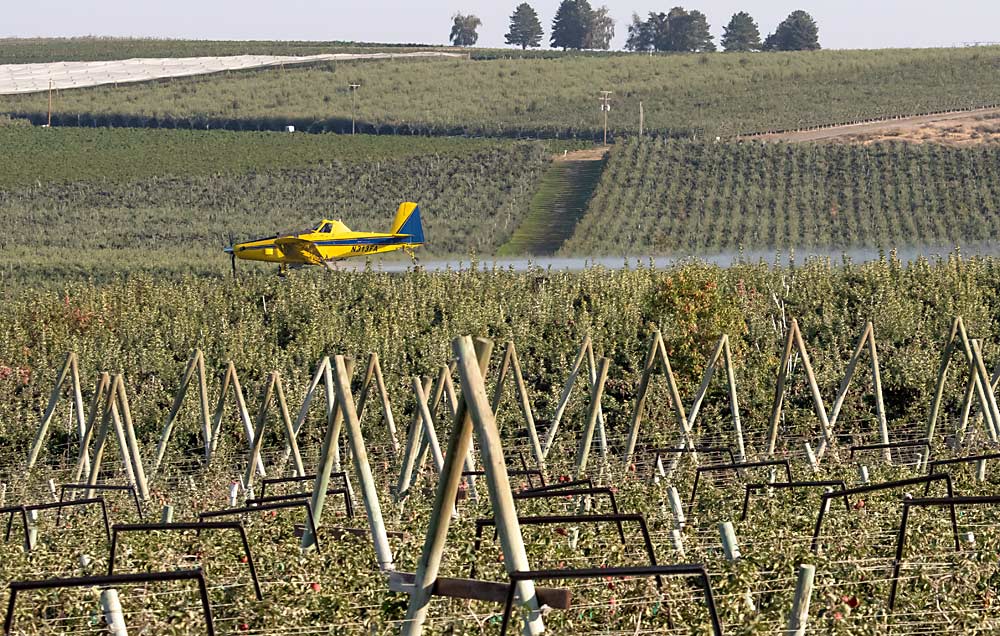
Red Beierle descends below the expansive Columbia Basin horizon to the tips of the apple trees, depositing a stream of stop-drop behind him. His Air Tractor 802 all but disappears into the rows before he pulls up into a bank seconds later.
The pass is complete: an entire row treated in a matter of seconds.
To spray an 80-acre orchard from the ground would take five sprayers all day, said Beierle, an aerial applicator based in Royal City, Washington. “We do it in 20–30 minutes.”
Time is the biggest attraction for hiring aerial applicators such as Beierle, and they’re not just for row crops. Tree fruit growers contract planes and helicopters to apply everything from plant growth regulators to sunburn protection. Aerial application in tree fruit has ebbed and flowed over the decades with changes in urban sprawl and chemical restrictions, but labor shortages, overtime rules and changing weather patterns may prompt more growers to look to the skies for help in the coming years.
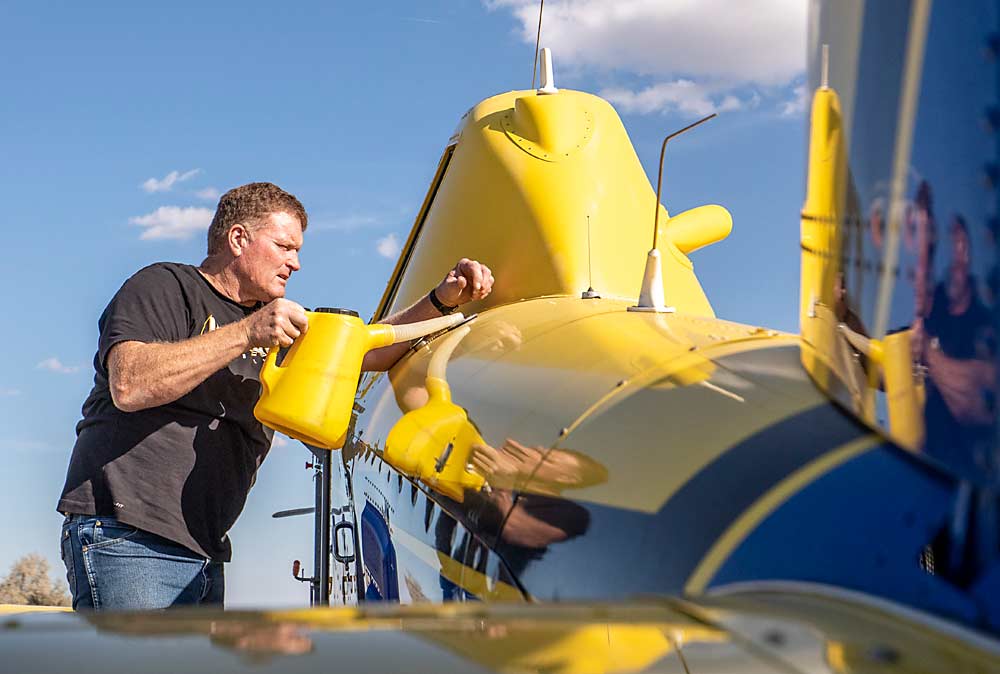
Grower uses
Washington Fruit uses aerial application for rodent control, plant growth regulators and insecticides, usually when the company has a lot of ground to treat in a hurry, said Jeff Leonardini, IPM manager for Washington Fruit and Produce Co. of Yakima.
“It’s amazing how fast they can cover a lot of property,” Leonardini said.
With rodent control, a granular substance applied to orchard floors, airplanes allow him to beat bad weather, especially snow. For stop-drop, typically applied right before harvest, ground crews are busy on other tasks. Bins or reflective color fabric may be in the way. Planes also can be gentler on fruit than the powerful fans on ground sprayers, he said.
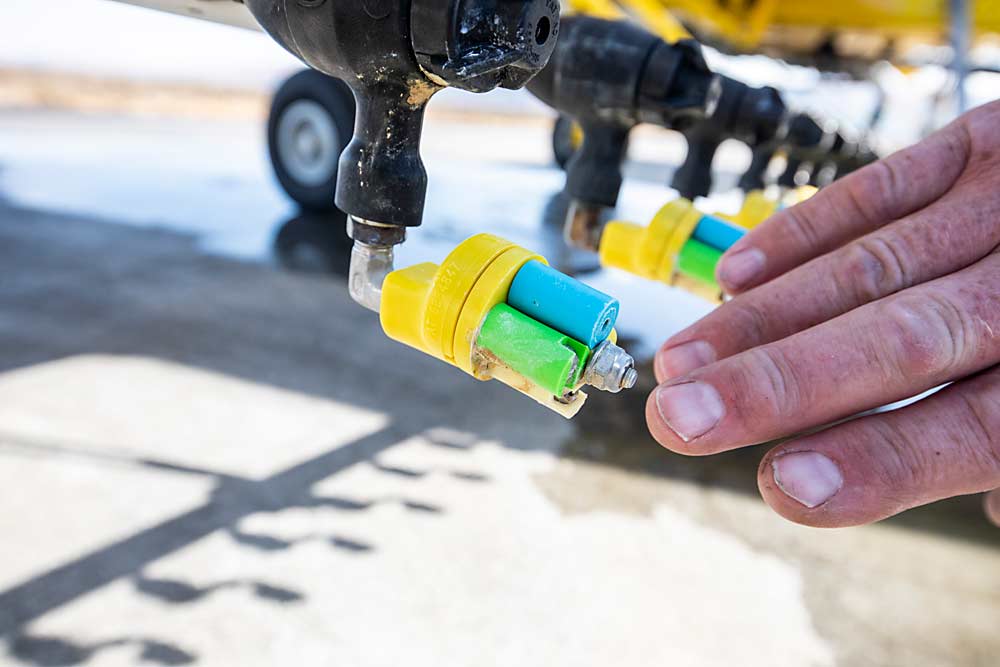
Coverage is better than people think, too, said Leonardini, a former partner in two California aerial agricultural service companies. At first blush, substances from the air would seem to fall straight down and hit only the tops of trees, but the complex air displacement created by planes and helicopters actually pulls droplets into canopies, he said. He has verified that with water-sensitive strips at Washington Fruit and in his former career in California.
He also opts to apply sunburn protection by air, in a sense from the sun’s perspective, Leonardini said. The company has run experimental trials on newer products and is working with the Washington State Department of Agriculture and manufacturers to get some of them labeled for commercial aerial use. He predicts aerial spraying of sunburn protectants and antitranspirants will become more common as climate change makes temperatures hotter and water scarcer.
“I think we’ll see a big shift in that, especially in the cherry industry,” to cool down trees postharvest and encourage bud initiation for the following season, he said.
Ever-rising labor costs also may drive more growers to aerial applicators, said Kelly Delay, a Royal City-area field representative and orchard manager for CPC International. Lawmakers in California and New York have mandated overtime pay for farmworkers, while many suspect Washington will do something similar after a recent state Supreme Court ruling. Growers may find planes attractive if, for example, fire blight conditions are forecast over a weekend, after crews already put in their 40 hours, Delay said.
Meanwhile, valves, nozzles, deflectors, computer integration and communication tools have improved aerial coverage and precision. Accuracy is within inches from a modern plane. “They’ve gotten just so good at it,” Delay said.
Dain Craver, a neighboring organic grower and consultant, has been turning to aerial applicators more over the past 15 years, as the technology improves. Craver uses aerial applicators for about 70 percent of his Serenade Optimum (Bacillus subtilis), an organic preharvest fungicide for apples and pears.
Limitations
Aerial application is not for everything, of course.
Delay tried applying stop-drop by air through louvred shade nets but was unimpressed with the coverage. Also, woolly apple aphid sprays need trunk coverage, something a plane doesn’t do well, he said.
Spider mites hide under leaves and in bark crevices, where ground application makes more sense, Leonardini said.
Even pilots know their limits.
“I’m not saying air application is best for all growers,” said Mark Brown, owner of Quincy Flying Service and a board member of the Pacific Northwest Aerial Applicators Alliance, which holds fly-ins and applicator educational events.
Aerial application has become more complicated over the years, Brown said. He recalls flying up and down the Okanogan Valley applying organophosphates, block after block. Those days are over.
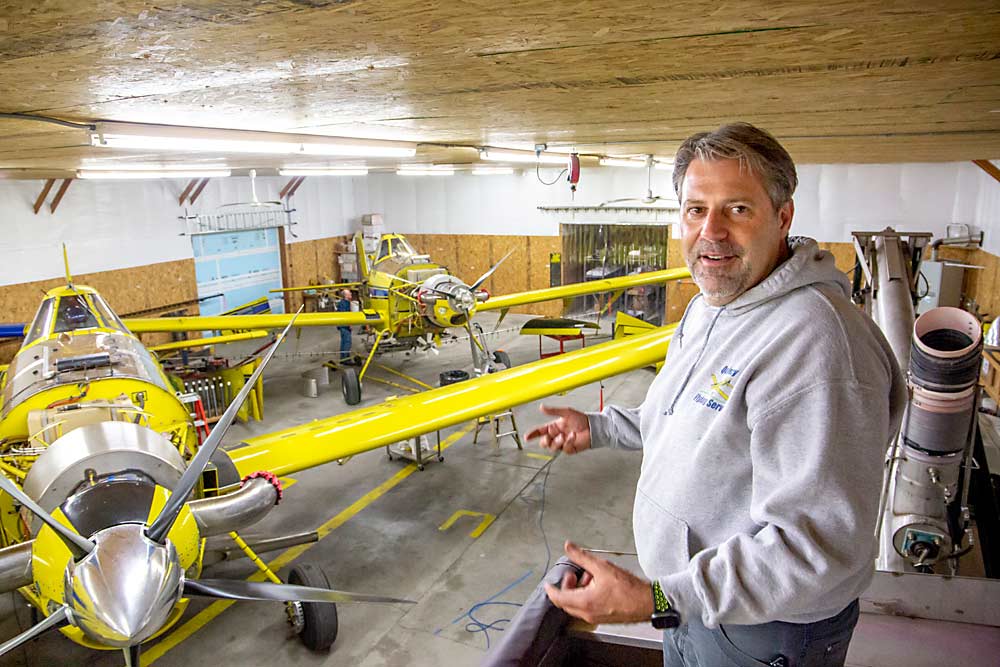
Beierle of Royal City, who has customers in the Columbia Basin, the Horse Heaven Hills and the Yakima Valley, thinks there are fewer aerial applicators today than when he started his business in 1983.
Cost-per-acre makes planes attractive to growers, but pilots need scale to be profitable. It costs more than $23 per minute to fly an agricultural plane. Just starting his and shutting it down runs $500, Beierle said.
Meanwhile, public perception has grown more challenging.
Most people don’t realize the extent of the safety technology and procedures in place, Beierle and Brown said. In 2019, Washington Republican Rep. Tom Dent, a retired Moses Lake aerial applicator, brought a bus load of state lawmakers to the Columbia Basin. When they toured Brown’s planes at the Quincy Municipal Airport, the technology and precision of the million-dollar aircraft impressed them, he said.
Generally speaking, aerial applicators must follow the same state regulations as ground sprayers, although there are location-specific aerial regulations in 16 Eastern Washington counties.
When it comes to complaints, pilots have bigger targets on their backs than do the growers who hire them. Investigations into aerial complaints usually focus on the pilot, said Tim Schultz, a Washington State Department of Agriculture compliance program manager in Spokane. “They’re the ones who hold the applicators’ licenses,” he said.
Growers need to understand the challenges pilots face, Brown said. For example, if workers are unexpectedly in an orchard they’re hired to spray, they can’t spray. Neither can they circle for hours, and they can’t always land a plane loaded with 800 gallons of material.
Helicopters
Planes need a big area and ground application is slow, so helicopters offer a middle ground. They do more than just dry cherries for the fruit industry, said Samantha Schmidt, the Yakima branch manager of North Wind Aviation.
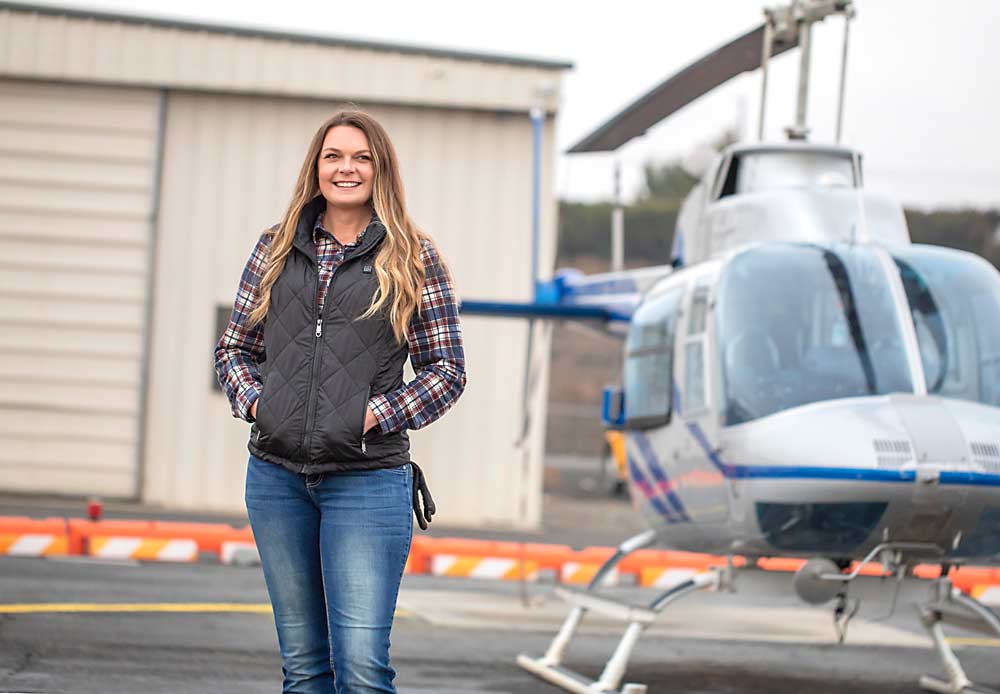
“They just think that we play one role,” she said.
Rotor pilots apply the same substances fixed-wing planes do, Schmidt said. She sprays about 9,000 acres of tree fruit each year but dries only about 1,000 acres of cherries. The second pilot at the Yakima branch does about the same.
Like planes, helicopters can cover a lot of ground in a hurry, which makes them attractive for growers in a time crunch. North Wind responds to plenty of last-minute calls and has been known to cover 7 acres per minute with rodent control, for example.
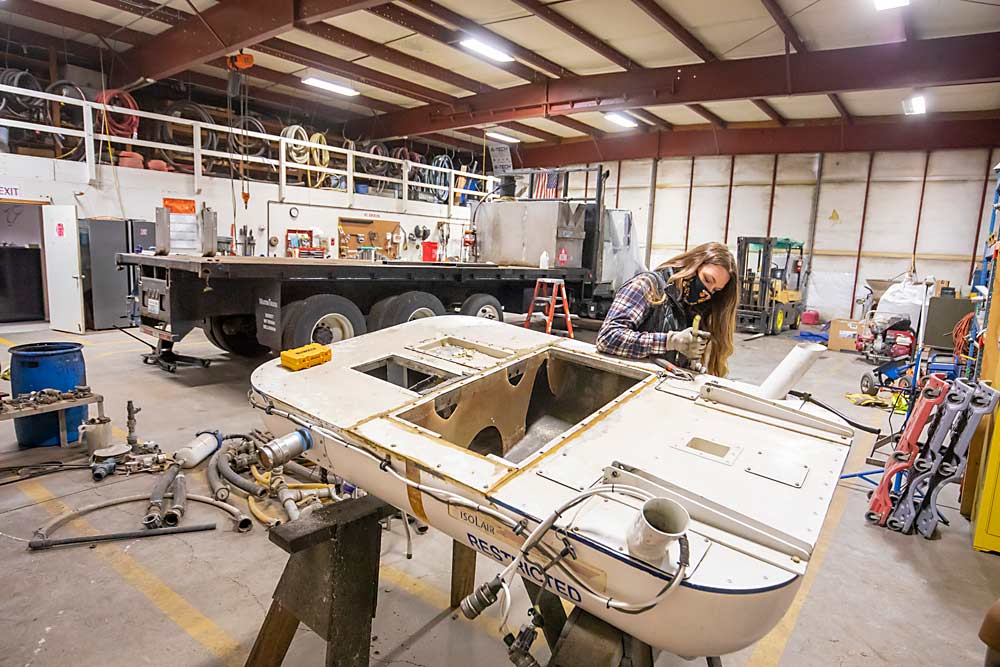
Helicopters don’t carry nearly the volume of fuel and product as planes, so pilots usually bring a batch truck to the application site, setting up shop in a bin stacking area or empty field. North Wind’s Yakima batch truck — also called a nurse truck — holds up to 3,000 gallons of water and has a 500-gallon mix tank, as well as up to 200 gallons of helicopter fuel, which requires the pilots and drivers to have hazmat certification. The helicopter itself can hold up to 100 gallons of spray product. The Air Tractor 802 plane, on the other hand, holds 800 gallons.
Schmidt has had few complaints from residents during her four years with North Wind. “A lot of people there know they moved next to an orchard that is probably going to be sprayed,” she said. •
—by Ross Courtney
Tips for working with pilots
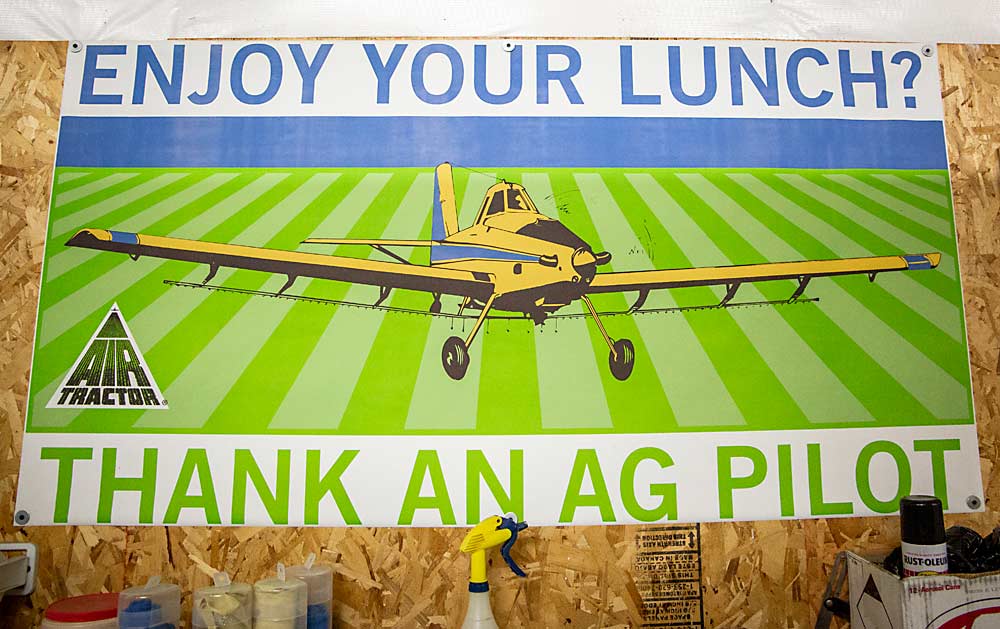
Agricultural pilots shared several tips for how growers can work with them for maximum safety and efficiency:
—Communicate. Pilots have phone capability in their helmets and can talk with growers on the ground to point out hidden hazards.
—Ensure workers are out of the field. That sounds obvious, but pilots have been surprised.
—Learn about neighboring blocks, especially if they are organic or transitional, and flag them with something pilots can see from the air, said Red Beierle of Royal City.
—Bright clothing can help, too. Mark Brown of Quincy Flying Service recommends neon vests like those worn by road workers. He has flown over fields and spotted a lone irrigation worker in a camouflage hoodie.
—Plan ahead. Sometimes growers want sprays right now, even if weather conditions don’t allow it, Brown said.
—Give helicopters plenty of space to take off and land. Yes, they are nimble compared to planes, but they can’t perform acrobatics when laden with fuel and application products, and they may miss spots when obstacles, such as houses or power lines, are in the way. “When we’re loaded down, we can’t do everything they see in the movies,” said Samantha Schmidt of North Wind Aviation.
—Provide accurate and updated maps. Pilots can create “shape maps” digitally based on GPS but often operate remotely with limited computer equipment. Schmidt recalled a time when an asparagus grower tried to draw her a map by hand. When she looked up the property on Google Maps, he initially pointed to someone’s front yard. Fortunately, she recognized the difference between grass and asparagus.
—R. Courtney







Leave A Comment